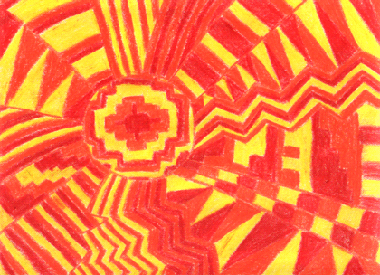First, some background info:
Arrow to the Sun
By Professor Donald Mitchell "a Practical Optimist" (Boston)
The key reason to read this book is to see some of the most remarkable modern renderings ever created of classic southwestern Native American pictograms. These pictograms are built from stylized geometric components combined into other geometric forms in a palette built mostly from yellow, orange, red, brown, and black. As accents, turquoise and green are added. These images are created with gouache (a thick form of water color) and preseparated black lines. These geometric shapes take literal beings and turn them into spiritual, conceptual ones. If you are like me, the transformation of the boy into the power of the rainbow against a sky of black will take your breath away. Not surprisingly, this book won Mr. McDermott the coveted Caldecott Medal in 1975 as the best illustrated children's book.
This is NOT a good book for teaching about Pueblo people, November 6, 2003
By Debbie Reese (Illinois)
With dismay, I read the customer reviews of this book. There are 19 Pueblos in New Mexico, and more in Arizona. Which Pueblo is this book about? There is great variation from one to the other. Most troubling, however, is McDermott's presentation of the kiva. Our kivas are not places of trial. They are more akin to churches and temples where cultural knowledge is passed on from one generation to the next. Finally, extended families are central to Pueblo culture, and there is no stain of illegitimacy conferred on those who don't know who their father is. This book should NOT be used to teach about Pueblo Indians. These errors are major ones.
Here's the opening paragraph, which is a synopsis of the book, followed by objectives:
In Arrow to the Sun, a boy, born from the sun, begins a quest to find his father. He travels through the world of men, finally finding his way back to the sun. Once there, he must prove himself through a series of tests. Only then can he return to the earth and the world of men again. In this Pueblo tale, students will be visually transported into the world of folklore and oral history that were and are cornerstones of Native American culture and tradition. The bold, imagistic art will captivate children as it lends to the magical quality of the story. This program provides an excellent starting point for Native American studies as well as a rich journey through the art and culture of Pueblo life.
Objectives
No. No. And no, again. Here's my rewrite. I'll put my revisions in red.
In Gerald McDermott's fantasy Arrow to the Sun, a boy, born from the sun, begins a quest to find his father. He travels through the world of men, finally finding his way back to the sun. Once there, he must prove himself through a series of tests. Only then can he return to the earth and the world of men again. In this tale, students will be visually transported into McDermott's imagined world of folklore and oral history. Though his book may feel like it is a presentation of Native American culture and tradition, it is only his imagined presentation. The bold, imagistic art will captivate children as it lends to the magical quality of the story. His book and this guide provide an excellent starting point for teaching children that information in books can be wrong. His book is used in courses in Native American studies to demonstrate how American Indian cultures are misrepresented in award-winning books.
Objectives
Comment: Reese does a fine job of ripping this book apart. It seems like something I'd do. <g>
If McDermott is indeed "retelling" a Pueblo tale, he should identify the source. It's more likely he's inventing a Pueblo tale.
If there was a source, we could see if there's any legitimacy to the story's conceits: a bastard boy searching for his father, the four kiva trials, the final "dance of life." As it is, we have to assume they're fabrications.
One thing I don't mind: making Arrow to the Sun a generic "Pueblo" tale. Would Reese object less if McDermott had named a particular tribe? I doubt it. I think she'd object more, and rightly so.
I'm guessing McDermott made the tribe generic to avoid offending one particular tribe. Although he probably shouldn't have written the book at all, at least he made one small effort to avoid offense.
I must admit I liked the Arrow to the Sun video when I saw it a couple decades ago. I appreciated its artistry and music.
I didn't try to analyze for its stereotypes because I didn't know much then. I may have to watch it again.
For more on the subject, see The Best Indian Books.

Below is an image of the sun, I presume. It's a stunningly good way of showing the sun as animate rather than inanimate--i.e., a being full of energy.


1 comment:
Interesting food for thought here. Exposing children to books is what I do. Sadly, I do not always know when someone has not verified information or embellished. Good post, thank you.
Post a Comment